ARTICLE AD BOX
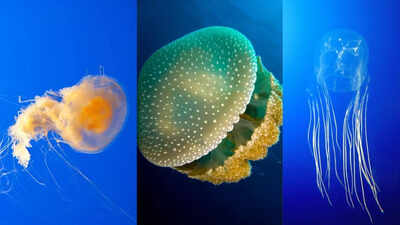
Jellyfish are some of the most fascinating and mysterious creatures in the ocean. While many people are familiar with the common jellyfish, there are countless lesser-known species that are just more captivating.
From glowing deep-sea drifters to jellyfish that resemble fried eggs or alarm systems, their diversity in shape, size and behavior is truly astounding. In this list, you’ll discover 10 unique jellyfish species that showcase the ocean’s wonder and complexity. Each one reveals something remarkable about marine life ranging from survival strategies to strange appearances that challenge what we think we know about sea creatures.
10 amazing jellyfish species
Cauliflower jellyfish
The Cauliflower jellyfish is a truly unique sight in the ocean thanks to its thick and bumpy bell that resembles a fluffy cauliflower head. This jellyfish floats gracefully in warm tropical and subtropical waters especially around the Indo-Pacific region. Its short and frilly tentacles trail beneath its bell helps in creating a soft and textured look. Though it has stinging cells, these stings are usually mild and not harmful to humans.
Beyond its unusual appearance, the Cauliflower Jellyfish plays an important role in the marine food chain by feeding on small plankton and providing food for larger sea creatures.
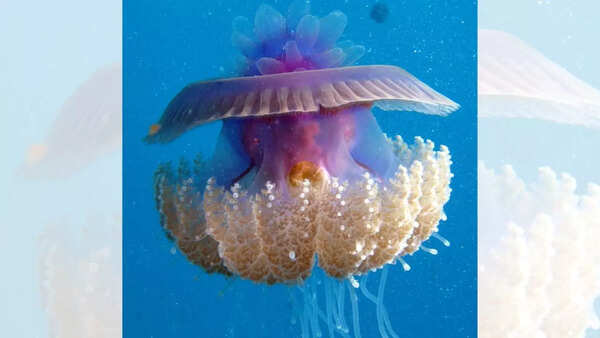
Source: Wikipedia
Mangrove box jellyfish
The Mangrove box jellyfish is a small but fascinating creature that lives in shallow and sheltered waters near mangrove forests. Unlike many jellyfish that simply drift, it actively swims using its box-shaped body and its sharpness helps in quick movements.
This jellyfish’s 24 eyes give it surprisingly good vision by helping it navigate through the murky water and avoid obstacles. Though tiny, which is about the size of a fingernail, it’s a skilled hunter that feeds on small shrimp and tiny fish.
Its sting is mild as compared to other box jellyfish that makes it less dangerous to humans but still a remarkable example of nature’s adaptability.
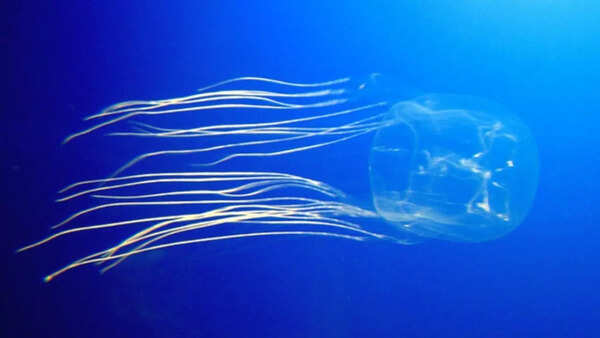
Source: Wikipedia
Crystal jellyfish
The Crystal jellyfish lives up to its name with its stunningly transparent and glass-like body that almost disappears in water.
These species are native to the Pacific Ocean, especially along the North American west coast. This jellyfish may look delicate but it’s a scientific powerhouse. It was the source of green fluorescent protein (GFP) which was a discovery that revolutionized modern biology and earned a Nobel Prize.
They typically grow up to 10 cm in diameter and glow faintly green in the dark thanks to bioluminescence. While harmless to humans, the Crystal jellyfish is a brilliant reminder of how some of nature’s most delicate creatures can illuminate entire fields of science.
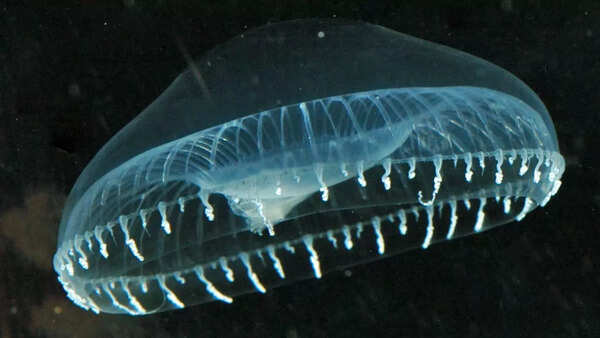
Source: Wikipedia
White-spotted jellyfish
They are graceful and easily recognizable because of their features, which is a translucent bell adorned with distinctive white dots that gives it a starry and ethereal appearance. They are originally native to the warm waters of the western Pacific, particularly around Australia and this species has now spread to various oceans worldwide, including the Gulf of Mexico and the Caribbean. Unlike many jellyfish, it feeds primarily by filtering plankton from the water thus they act as a kind of underwater vacuum cleaner.
Though it can sting, it poses little threat to humans. Despite its gentle nature, its rapid spread in some areas has raised ecological concerns that makes it both beautiful and controversial.
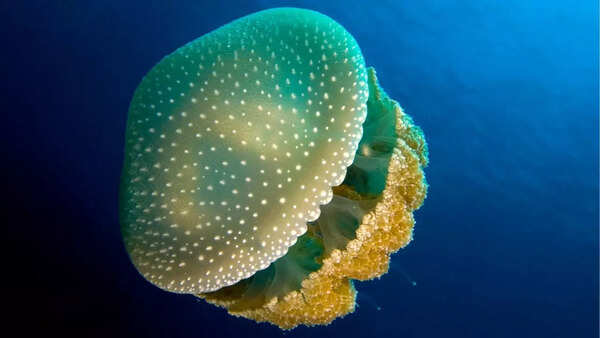
Source: Wikipedia
Upside-down jellyfish
Unlike most jellyfish that drift with their bell facing upward, the Upside-Down Jellyfish prefers to rest on the ocean floor by bell down and tentacles waving upward. They are found in shallow warm coastal waters around the world, especially in mangroves and lagoons and this unique behavior allows it to host photosynthetic algae within its tissues.
These algae produce nutrients through sunlight that are essential for feeding the jellyfish in return.
Its delicate and frilly tentacles shimmer with colors ranging from golden to bluish hues creates a mesmerizing underwater spectacle. They are harmless to humans and are a perfect example of nature’s unexpected adaptations.
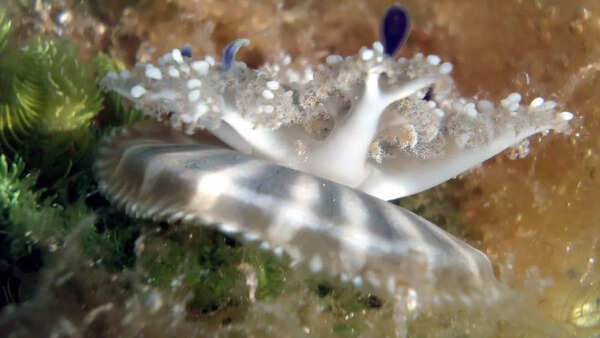
Source: Wikipedia
Black sea nettle
The Black Sea Nettle is a striking giant of the jellyfish world that is known for its deep and almost inky black bell that can reach up to 1 meter across.
They are found mainly in the coastal waters of the eastern Pacific Ocean, particularly off California, this mysterious jellyfish drifts gracefully with long and flowing tentacles that can stretch over 5 meters. Its dark color helps it blend into the deep ocean shadows and makes it both beautiful and elusive.
While its sting is potent for small prey, it poses little risk to humans but remains an awe-inspiring sight for divers lucky enough to encounter it.
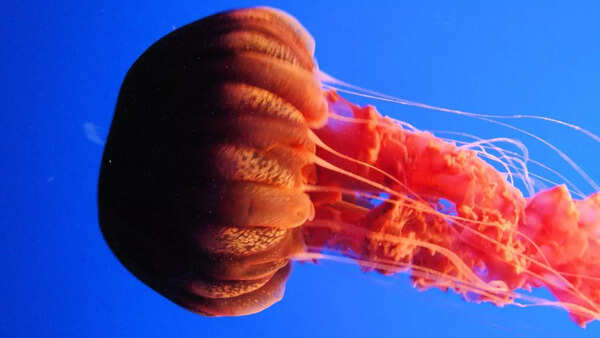
Source: Wikipedia
Fried egg jellyfish
They are named for their unique appearance that resembles a sunny-side-up egg and the Fried Egg Jellyfish is a charming and unusual species that are found mostly in the Mediterranean Sea. Its translucent bell is topped with a bright yellow dome-shaped structure that looks like an egg yolk that makes it instantly recognizable. This jellyfish is often spotted floating near the surface where it feeds on plankton and small fish.
They are harmless to humans and their look makes them a favorite among divers and marine enthusiasts, reminding us that the ocean is full of playful surprises.
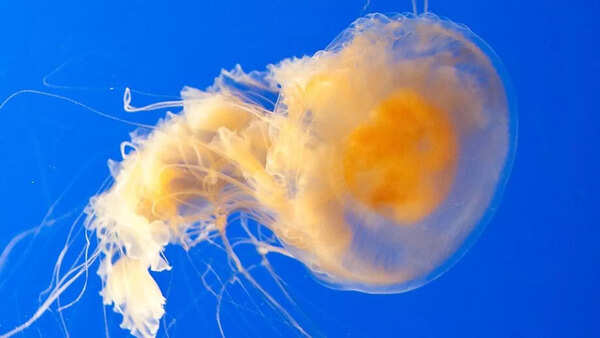
Source: Wikipedia
Lion's mane Jellyfish
The Lion’s Mane Jellyfish is one of the largest jellyfish species in the world which is easily recognized by its massive and flowing tentacles that resemble a lion’s mane hence as their name. They are found mostly in the cold waters of the Arctic, North Atlantic and North Pacific Oceans.
Its bell can reach over 2 meters in diameter with tentacles extending up to 30 meters. Despite its intimidating size, it feeds primarily on small fish and plankton.
While its sting can be painful, it’s rarely fatal to humans. The Lion’s Mane Jellyfish is a true ocean giant and a breathtaking example of marine magnificence.
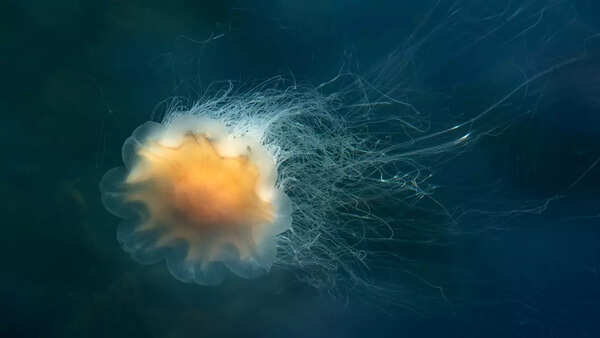
Source: Wikipedia
Atolla jellyfish
They are known as the "alarm jellyfish," the Atolla Jellyfish is a deep-sea marvel famous for its stunning bioluminescent display.
They are found in the dark depths of oceans worldwide and they produce a mesmerizing blue glow when threatened by flashing bright rings of light to confuse predators and attract help from other creatures. Its bell is typically around 15 centimeters wide and fringed with long and trailing tentacles.
Despite living thousands of meters below the surface, the Atolla’s glowing light creates an otherworldly spectacle that has fascinated scientists and ocean explorers alike that makes it one of the most enchanting deep-sea jellyfish.
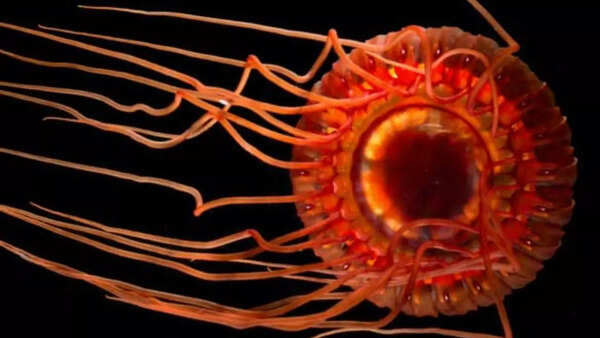
Source: Wikipedia
Narcomedusae
Narcomedusae are a fascinating group of jellyfish that are known for their unique body shape and surprising hunting skills. Unlike typical jellyfish with large bells, Narcomedusae have flattened umbrella-like bodies with tentacles that extend from the edges which gives them an alien appearance. These deep-sea dwellers are agile predators who use their tentacles to capture small crustaceans and plankton with quick and precise movements.
They are often transparent or pale in color and they drift silently through the dark ocean depths. Their unusual form and stealthy hunting style make Narcomedusae one of the ocean’s most intriguing and mysterious jellyfish groups.

Source: Wikipedia
10 fascinating facts about jellyfish
Jellyfish possibly existed prior to dinosaurs
Jellyfish possibly existed long before dinosaurs with evidence suggesting that they appeared over 500 million years ago during the Cambrian period. Jellyfish’s simple and soft-bodied structure which lacks bones and a brain has helped them to survive numerous mass extinction events and adapt to changing ocean conditions.
Their ability to thrive in diverse environments has made them some of the oldest living creatures on Earth.
Unlike dinosaurs, which dominated land ecosystems for millions of years before going extinct, jellyfish have continued to flourish in the oceans and are showcasing their incredible resilience and ancient origins.
Jellyfish successfully adjusting to climate shifts
Jellyfish are successfully adjusting to climate shifts caused by rising ocean temperatures and changes in water chemistry.
Unlike many marine species, jellyfish can tolerate warmer and low-oxygen environments which gives them a survival advantage. Their rapid reproduction and limited natural predators enable their populations to grow quickly by often resulting in large blooms. These blooms can impact local ecosystems and fisheries by disrupting food chains and competing with other marine life.
Jellyfish’s ability to thrive under changing conditions highlights their resilience and adaptability makes them one of the few species that benefit from the challenges posed by climate change in the oceans.
They are not classified as fish
Despite their name, jellyfish are not true fish. Fish are vertebrates which means that they have a backbone along with other characteristics like gills and fins. Jellyfish, on the other hand, are invertebrates as they lack a backbone entirely. They belong to a group called cnidarians which also includes sea anemones and corals. Jellyfish have a simple body made mostly of water with a soft, bell-shaped form and tentacles.
Instead of bones, they rely on a jelly-like substance for structure. Their anatomy and biology are very different from fish which is why scientists don’t classify them as fish at all.
Jellyfish body is made up of 98% water
Jellyfish bodies are made up of about 98% water which is why they have a soft and gelatinous texture. This high water content makes them very light and flexible that allows them to move gracefully through the ocean. Their structure consists mostly of a jelly-like substance called mesoglea which is sandwiched between two thin layers of cells.
Because they are mostly water, jellyfish can easily float and drift with ocean currents.
This composition also means that they don’t need heavy bones or muscles to move as they help them to conserve energy as they navigate their watery environment.
Certain jellyfish could live forever
Some species of jellyfish like Turritopsis dohrnii are known as “immortal jellyfish” because of their unique ability to potentially avoid aging and death. When faced with stress, injury or old age, these jellyfish can revert their cells back to an earlier stage of development which is a process called transdifferentiation.
This allows them to transform from a mature adult back into a juvenile polyp stage, essentially starting their life cycle over again.
This remarkable ability means that they can theoretically repeat this cycle indefinitely which makes them biologically immortal under ideal conditions. However, they can still die from disease or predators.
Jellyfish eat and excrete together
Jellyfish have a very simple digestive system with just one opening that serves as both their mouth and anus.
This means they take in food and expel waste through the same hole. After capturing prey with their tentacles, jellyfish bring the food to this opening to digest it inside their gastrovascular cavity. Once digestion is complete, any waste materials are expelled back out through the same opening. This simple design works well for jellyfish allows them to process food efficiently even though their bodies lack complex organs like separate mouths and intestines.
They often travel individually
Jellyfish usually drift alone through the ocean rather than travelling in groups. Unlike fish that swim in groups for protection or hunting, jellyfish tend to move independently because their movements mostly depend on ocean currents. While sometimes large groups called blooms or swarms occur these gatherings are more about favorable conditions like food availability rather than social behavior. Travelling solo allows jellyfish to cover wide areas and take advantage of different food sources without competition from others.
Their simple nervous system doesn’t support complex group behaviors so individual drifting is their natural way of life.
They are one of the world’s deadliest species
Some jellyfish species are incredibly dangerous because of their potent venom. For example, the box jellyfish has toxins that can cause extreme pain, paralysis, and even death in humans. Their venom attacks the heart, nervous system and skin cells which make these stings potentially life-threatening without immediate medical treatment.
Despite their simple appearance, these jellyfish possess one of the most powerful venoms in the animal kingdom.
While not all jellyfish are deadly, the ones that are make them some of the most feared creatures in the ocean and among the deadliest animals on the planet.
Certain jellyfish are safe to eat
Not all jellyfish are edible but some species are considered a delicacy in various parts of the world especially in Asian cuisines. These edible jellyfish are typically processed by drying or pickling to reduce their high water content and improve texture. They’re often used in salads, soups and stir-fries as they are valued for their crunchy texture rather than strong flavor. Eating jellyfish can be a good source of protein and low in calories.
However, it’s important to properly prepare them to remove any toxins and ensure they’re safe for consumption.
Also read: Discover 5 massive giant crocodiles that are now extinct



.png)
.png)
.png)
















 15 hours ago
4
15 hours ago
4









 English (US) ·
English (US) ·